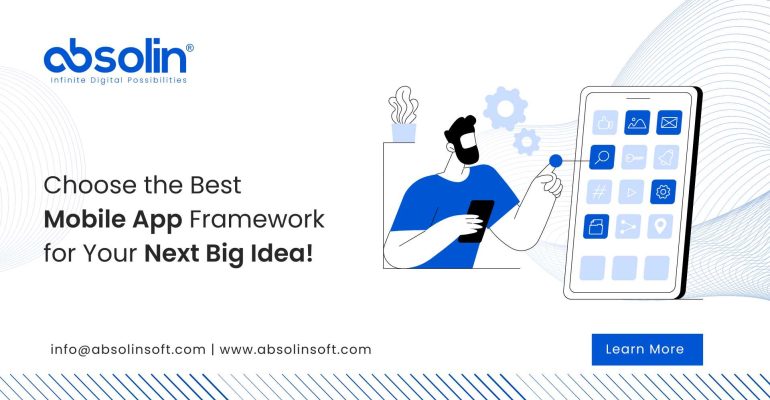Top Mobile App Development Frameworks: Choosing the Right One for Your Project

Top Mobile App Development Frameworks: Choosing the Right One for Your Project
In the ever-expanding world of mobile applications, choosing the right development framework is a critical decision that can significantly impact the success of your project. The right framework can streamline the development process, enhance performance, and ensure a seamless user experience across devices. With a plethora of options available, selecting the best framework can be challenging. In this blog, we’ll explore some of the top mobile app development frameworks and provide insights to help you choose the right one for your project.
1. React Native
Overview: Developed by Facebook, React Native has gained immense popularity for building cross-platform mobile applications using JavaScript and React. It allows developers to write code once and deploy it on both iOS and Android, reducing development time and costs.
Advantages:
- Cross-Platform Compatibility: Single codebase for iOS and Android.
- Large Community Support: A vast developer community, making it easier to find resources and troubleshoot issues.
- Performance: Near-native performance with smooth animations and fast load times.
- Reusable Components: Offers reusable components, speeding up the development process.
Use Cases: Ideal for startups and businesses looking to launch apps on multiple platforms quickly. Suitable for social media apps, e-commerce platforms, and apps with simple UI/UX.
2. Flutter
Overview: Flutter, developed by Google, is a UI toolkit for building natively compiled applications for mobile, web, and desktop from a single codebase. It uses the Dart programming language and offers a rich set of pre-designed widgets.
Advantages:
- Hot Reload: Allows developers to see changes in real-time without restarting the app.
- Customizable UI: Provides extensive customization options, enabling the creation of highly attractive UIs.
- High Performance: Delivers near-native performance, with smooth animations and fast rendering.
- Single Codebase: Supports cross-platform development with one codebase.
Use Cases: Best suited for projects that require high-quality UI designs and custom animations. Commonly used for apps in the finance, healthcare, and e-commerce sectors.
3. Ionic
Overview: Ionic is an open-source framework for building hybrid mobile applications using web technologies like HTML, CSS, and JavaScript. It integrates seamlessly with Angular, React, and Vue.js, making it a flexible option for web developers transitioning to mobile app development.
Advantages:
- Web Technology Compatibility: Leverages web development skills for mobile app creation.
- Cross-Platform Development: Write once, deploy across iOS, Android, and the web.
- Wide Range of Plugins: Access to native device features through Cordova and Capacitor plugins.
- Strong Community Support: Extensive documentation and a large community for support.
Use Cases: Ideal for developers with web development experience looking to create hybrid apps quickly. Suitable for building simple apps, prototypes, and progressive web apps (PWAs).
4. Xamarin
Overview: Xamarin, now part of Microsoft, is a popular framework for building cross-platform mobile applications using C# and .NET. It allows developers to share up to 90% of their code across platforms, making it a powerful tool for enterprise-level applications.
Advantages:
- Native Performance: Delivers near-native performance with access to native APIs.
- Code Reusability: High code-sharing capability between iOS and Android.
- Microsoft Ecosystem Integration: Seamless integration with Microsoft’s ecosystem, including Azure, Visual Studio, and .NET.
- Strong Community and Support: Backed by Microsoft, with extensive documentation and enterprise-level support.
Use Cases: Best suited for enterprise applications that require high performance, security, and integration with Microsoft products. Commonly used for business applications, data-driven apps, and complex mobile solutions.
5. SwiftUI (for iOS Development)
Overview: SwiftUI is Apple’s modern UI framework for building iOS, macOS, watchOS, and tvOS applications. It simplifies the development process by allowing developers to write declarative code, creating UIs with less code than traditional approaches.
Advantages:
- Native iOS Development: Optimized for Apple devices, ensuring the best performance and user experience.
- Declarative Syntax: Simplifies UI development with a clear and concise syntax.
- Integration with Swift: Seamless integration with Swift, Apple’s powerful programming language.
- Live Previews: Allows developers to see changes in real-time within Xcode.
Use Cases: Ideal for developers focusing exclusively on Apple’s ecosystem. Suitable for building iOS applications with complex UIs, custom animations, and high performance.
6. Apache Cordova
Overview: Apache Cordova is an open-source mobile development framework that allows developers to build mobile apps using HTML, CSS, and JavaScript. It provides access to native device features through plugins, enabling the creation of hybrid applications.
Advantages:
- Web Technology Compatibility: Leverages existing web development skills.
- Cross-Platform Development: Supports multiple platforms with a single codebase.
- Wide Plugin Support: Extensive plugin library for accessing native device features.
- Open-Source: Free to use with a large community contributing to its development.
Use Cases: Suitable for simple, content-driven apps, and prototypes. Often used by web developers transitioning to mobile app development.
How to Choose the Right Framework for Your Project
Choosing the right mobile app development framework depends on various factors, including your project requirements, target audience, budget, and development timeline. Here are some key considerations to help you make the right choice:
- Project Scope: Assess the complexity of your app and the features it requires. Native frameworks like SwiftUI are ideal for complex, performance-intensive apps, while cross-platform frameworks like React Native and Flutter are suitable for simpler apps with broad platform support.
- Developer Expertise: Consider the skills and experience of your development team. Choose a framework that aligns with their expertise to minimize the learning curve and accelerate development.
- Target Platforms: Determine whether you need to target iOS, Android, or both. Cross-platform frameworks like Xamarin and React Native offer the advantage of reaching multiple platforms with a single codebase.
- Time-to-Market: If speed is a priority, opt for frameworks that offer rapid development and deployment, such as Flutter’s hot reload feature or React Native’s cross-platform capabilities.
- Budget: Evaluate your budget and resources. Cross-platform frameworks can reduce development costs by allowing you to reuse code across platforms, while native frameworks may require separate development efforts for each platform.
- Performance Requirements: Consider the performance demands of your app. For apps requiring high performance and access to native device features, native frameworks like SwiftUI or Xamarin may be the best choice.
Conclusion
Selecting the right mobile app development framework is a crucial step in ensuring the success of your project. By understanding the strengths and weaknesses of each framework and aligning them with your project’s goals, you can make an informed decision that leads to a high-quality, successful mobile application. Whether you choose React Native, Flutter, Ionic, Xamarin, or another framework, the key is to choose one that best suits your project’s needs and long-term vision.





